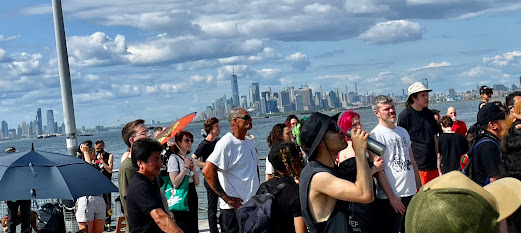
(Drivebycuriosity) - The USA is the most powerful & wealthiest
country of the world. How did that happen? Why did the US flourish while
countries like Brazil and Argentina did not, even though they started
with similar advantages? John Steele Gordon answers these and a lot of other questions in his excellent book "An Empire Of Wealth - Rise Of The American Economy 1607-2000" (amazon).
Gordon wrote not only a concise economic history of the United States,
he also gives a top-notch introduction into advanced economics. "Empire"
is very clearly & catchy written and I learned a lot by reading
this book. Below some tidbits from the vast knowledge the author
stretched over 492 pages:
Why could Europe dominate the whole world for centuries and conquer
& develop the American continent? The old continent was more
technological advanced then the rest of the world and benefited from a
row of innovations & inventions:
- the invention of the printing press in the Renaissance
reduced the cost of books, and thus of knowledge. Cheap information
fostered the rise of science and (early) technology, it promoted trade
and helped managing corporations.
- the creation of full-rigged ships made long passages across oceans possible and supported America´s immigration.
- the initiation of double-entry booking made accounting easier and more reliable. It became much easier to detect errors and helped to
invest in complicated & distant enterprises. It also helped to keep track of how these
investment are doing.
- the launch of the joint-stock company, the precursor of today`s
stock market listed companies, limited the risk an individual investor
had to take and made it possible to amass big sums to invest in distant
places like the American colonies. New York, Virginia and the New
England colonies were not founded by the English state; they were
founded by profit-seeking companies.
Get Up & Go
According to Gordon the "get-up-and-go mentality" was also an important factor for America´s rise. Americans are descended from those who got up and came - "those who
chose to leave all they had ever known and come to a strange and distant
land came to pursue their own ideas of happiness".
The willingness to
accept present discomfort and risk for the hope of future riches - that characterized these immigrants, and the millions who would follow over
the next two centuries - has had a profound effect on
the American history.
America`s rise as industrial nation was driven by inventors &
entrepreneurs like Samuel Slater, who developed a
cotton spinning machine in the 18th century and Oliver Evans, who
created a flour mill, the steel magnate Andrew Carnegie and Cornelius Vanderbilt, who was one of the first who built great industrial and transportation empires in the late 19th century.
Railroads had an important role in the development of the vast nation. "In Europe railroads
connected existing cities. In America, in many cases, they midwived
them into existence". In the early 1920s Henry Ford, who was
obsessed with driving production costs lower, made cars affordable for
the masses and created so a huge industry and wealth for the whole
nation.
All these factors worked beneficially together. "In the half century
between the end of the Civil War and the beginning of World War I in
Europe, the American economy changed more profoundly, grew more quickly,
and became more diversified that at any earlier fifty-year period in
the nation´s history". In 1865 the country was still basically an
agricultural one. By the turn of the twentieths century the United
States had the largest and most modern industrial economy on the earth,
characterized by giant corporations undreamed of in 1865.
Boom & Bust
But America´s rise wasn´t smooth, instead it was a bumpy ride. While the American economy grew at an astonishing
rate, it also was the most volatile in the Western world, subject to an
unending cycle of boom and bust whose amplitude far exceeded the normal
ups and downs of the business cycle.
In the 19th century America suffered frequent crashes of banks, railroads and other
companies which started a panic leading to a depression. "Seller´s panic produce, by their nature, a sudden surge in demand
for money as investors and depositors seek liquidity, and money, of
course, is the ultimate liquid asset.
Because there was no central bank
empowered to regulate the money supply and to provide the liquidity
needed to protect the banking system in times of stress, these
sellers`panics greatly exacerbated the downward swings of the business
cycle. Basically sound institutions collapsed by the hundreds when they
were unable to meet the sudden demand for money. Often they took the
life savings of families and the liquid assets of businesses with them".
One of the worst depressions started January 1837. The price of cotton,
then an important income source for the US economy, fell by half in
March. By April Philip Hone, a former mayor of New York, wrote in his
diary that "the immense fortunes which we have heard so much about in
the days of speculation, have melted like the snows before an April sun.
No man can calculate to escape ruin but he owes no money; happy is he
who has a little and is free from debt." By early fall, 90% of the nation´s factories were closed. Federal revenues fell by half in 1837. The depression didn´t reach bottom until February, fully 72 months after in began. Compare this with the recession from 2008!
Another depression began in early 1893. "By the end of the year some fifteen thousand
companies had failed, along with 491 banks. The gross national product
fell by 12%, and unemployment rose rapidly from a mere 3% in 1892 to
18.4% two years later".
Jefferson´s Rural Utopia
America owned these frequent crises partly to Thomas Jefferson. The
third President of the US (1801-09 ), a land owner and slave holder, defeated his political opponent
Alexander
Hamilton, who wanted to create an central bank. Jefferson had a deep
political aversion to cities and to the commerce that
thrives them and described himself as “an enemy of banks”. His vision of
the future of America was a land of self-sufficient yeomen farmers, a
rural utopia.
Jefferson,
born one of the richest men in the American colonies - on his father`s
death he inherited more than five thousand acres of land and three
hundred slaves - spent money all his life with a lordly disdain for
whether he actually had any to spend. He died, as a result, deeply in
debt, "bankrupt in all but name”.
Jefferson - and later his followers - balked
Hamilton`s plan to create a central bank, modeled on the Bank of
England. This institute should
regulate the money supply by disciplining the private banks and should
also be a source of loans for the government and other banks. But thanks
to Jefferson and his followers for more than a century America had to
do without out financial fire fighters.
At the turn of the 19th century
one man emerged who tried to fill the gap: JP Morgan. The New
Yorker banker used his own huge fortune and his enormous influence on
Wall Street to hinder the
bank panic from 1907 to evolve into a full-fledged depression. Using his
own wealth and his power persuasion he talked other banks to pump
liquidity into the market.
The awareness that a man of the stature and
probity of J.P. Morgan might be able to avert
financial calamity in the future, but there was no guarantee that there
would be such a man available, lead to the creation of the Federal
Reserve System (Fed), the central bank, in 1913 - finally.
The Great Depression
After World War I only the United States emerged from the struggle
materially strengthened and Wall Street replaced London`s Lombard Street
as the world`s leading financial power. Cheaper cars and falling costs
for electricity caused productivity to
soar in the 1920s, increasing output per worker by 21.8 in the decade.
This helped to push manufacturing output up by more than 90%. Economic
growth fueled optimism and the stock market - a huge rally took off.
By the spring of 1929 the financial market began to disconnect from the
economic fundamentals. The Dow Jones Industrial Average and the New York
Times Index of widely hold stocks continued to rise while the economy
began to move into recession, thanks to the Fed who started rising
interest rates to clamp down the money supply. But the wider market,
including thousands of secondary stocks and those not included in the
most widely watched averages, had begun to decline along with the
economy.
On September 5 leading stocks like U.S. Steel & AT&T dropped in
the last hour of trading sharply. Over the next six weeks the market
trended downward, with occasional plunges followed by more modest
recoveries. On October 23 a wave of selling swept the market, causing a
mountain of margin calls (broker cancelling stock loans) which
accelerated the selling. Thursday, October 24, the Black Thursday,
was the most frantic in the history of the New York Stock Exchange so
far.
Short sellers, who borrowed stocks and sold them immediately in the
hope to buy them back much cheaper, made the drop worse, as they always do. Purchases by
banks who tried to stop the panic caused a very short live rally, just a
dead-cat-bounce.
On Monday the selling resumed and on Tuesday, October
29, the Black Tuesday, the market plunged massively. Der Dow
Jones Average at the end of the day stood 23% below where it had closed
on Saturday, and nearly 40% below its high of early September.
Rookie Mistake
But, as Gordon explains, the stock market crash didn`t cause the crisis,
the sharp fall was just an effect of the forces moving the American and
world economies into depression. Although the stock market had been an
national obsession in 1929, its crash had not directly affected that
many families - less than 2.5% of the population had brokerage accounts.
The Federal Reserve, still young & inexperienced, made a rookie mistake:
The Fed did not move decisively to add liquidity to the banking system
nationally. In the year 1931 the Federal Reserve moved aggressively to
defend the dollar and maintain the gold standard as foreign banks and
investors moved to repatriate gold. "It was an utterly disastrous
decision, perhaps the greatest of all mistakes made in these years",
comments Gordon. "Maintaining the gold standard required raising
interest rates and cutting the money supply, causing an already severe
deflation to become much more severe." Banks called loans to stay
liquid, while customers postponed purchases in expectation of lower
prices. As Milton Friedman & Co-author Anna Schwartz described, from the fall of 1930 through the winter of 1933, the money supply fell by nearly 30 percent, which made the depression even more severe.
The Smoot-Hawley Tariff Act was another fateful mistake. This regulation
put high tariffs on imported goods. "Tariffs are taxes, and taxes,
inescapably, are always a drag on the economy. But far worse, high
tariffs breed retaliatory tariffs in foreign countries". Great Britain
and other countries nations responded with sharp restriction of US
exports - as result the world trade began to collapse. Today`s trade war with China and other countries looks dangerous as well.
Starting in the year President Franklin Roosevelt implemented the New Deal, a long list of measures, to revive the US economy, including the Glass-Steagall Act which separated deposit from investment bank to reduce power and risks of the banks.
Unprecedented Boom
At the end of World War II many economists & business leaders
predicted a new depression because of the lacking military demand again.
Instead an unprecedented boom started through the early 1970s. In the
begin the US economy got some tailwinds from the GI Bill of Rights. This
program was originally intended to reward veterans for their bravery
and sacrifice in the war. It provided generous payments to veterans for
education, buying houses and investing into businesses.
The post-war
boom ended when OPEC implemented an oil embargo to punish the West for
Israel´s Yom Kippur War (Oil Shock) which caused high
inflation rates and new recessions. The US economy, which relied heavily
on the car, was hit hard. President Ronald Reagan - and falling oil
prices - rekindled the economy in the 1980s and a new period of
prosperity started which lasted through the year 2,000.
In October 1987 the stock market crashed again and suffered the worst
one-day decline in percentage terms - 22.8% - in history. But the
market recovered 104 points the next day and reached a new high on the
Dow within 15 months, "The reason, principally, was that the Federal
Reserve acted immediately and decisively to stem the panic and to
protect the economic institutions of the country from harm". It "flooded
the street with money", as it pumped massive liquidity into the
economic system. The US economy grew 3.6% in 1987 and advanced 4.2% in
1988 in spite of the stock market turmoils. For the first time since
Alexander Hamilton had stemmed the panic of 1792, federal monetary
authorities had performed as the should in a moment of financial crisis.
The book ends with the stock market meltdown of 2000/01 and some words
about the economic impact of 9/11. I really would enjoy if Gordon´s would also write an
analysis and description of the 2008 financial crises and the recovery.
A Man Who Dies Rich, Dies Disgraced
Gordon
claims that the US "has never developed an aristocracy, because the
concept of primogeniture, with the eldest sun inheriting the bulk of the
fortune, never took hold. Thus great fortunes have always been quickly
dispersed among heirs in only a few generations. The American super rich
are therefore always nouveau riche". He continues "the giving of vast
sums to eleemosynary institutions by the very rich is a uniquely
American practice; the European upper classes have no such traditions".
It began with people like George Peabody (The Peabody Museums at
Harvard and Yale, among much else), Peter Cooper (The Cooper Union,
still the only major college in the US to charge no tuition) and John
Jacob Astor, whose Astor Library is today the core of the New York
Public Library, the larges privately financed library in the world).
As
the 19th century began to wane, the people who were building great
fortunes - like Henry Clay Frick,
John d. Rockefeller &J.P. Morgan - began to found or endow museums, concert halls, orchestras,
colleges, hospitals, and libraries in astonishing numbers in every major
city. The billionaire Carnegie -one of these donators - wrote, that "a man who dies rich, dies disgraced"
and gave away nearly his entire fortune.
Conclusion: I learned how the US became the richest nation on
earth, how economic crises arise and how to fight them, how the gold
standard & and new tariffs made the Great Depression even more
worse, what America´s super rich do with their money and a lot more.








































